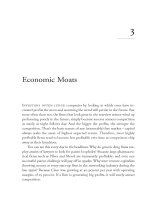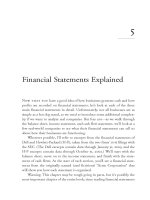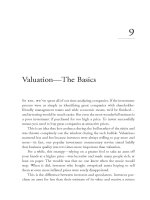cheng - taming the money sharks; 8 super-easy stock investment maxims (2013)
Bạn đang xem bản rút gọn của tài liệu. Xem và tải ngay bản đầy đủ của tài liệu tại đây (3.03 MB, 221 trang )
Additional Praise for Taming
the Money Sharks
“For those investors who want to pro t from the
investment markets like professionals, this book is
the key to success in eight simple steps. You will
nd Professor Cheng’s investment language in
sync with our daily lives—complex theories are
replaced with real-life examples and interactive
illustrations pinpoint the fundamental knowledge
we all need to know to accumulate and protect
our wealth.”
—Patrick K.S. Wong, Former General
Manager, Jardine Fleming Taiwan
Investment Management Ltd;
Investment Director, Jardine Fleming
Unit Trusts Ltd Hong Kong; President,
Polaris Investment Trust, Taiwan
“Mr. Cheng has written a highly readable guide
for individual stock market investors who wish
to develop an organized approach to creating and
managing their portfolios. He uses real-life exam-
ples to e ectively illustrat e investing pitfalls and
principles, while presenting tools and techniques
that are valuable to the discipline needed for
success in this activity. Rooted in common sense
and conservative principles, his investing frame-
work will best serve individuals who are willing to
make a serious commitment of time and energy
toresearch, trade execution, and ongoing portfolio
management activities.”
—Richard Mellon, Retired
Financial Manager
Taming the
Money Sharks
Taming
the Money
Sharks
8 Super-Easy Stock
Investment Maxims
Philip Shu-Ying Cheng
Copyright © 2013 by John Wiley & Sons Singapore Pte. Ltd.
Published by John Wiley & Sons Singapore Pte. Ltd.
1 Fusionopolis Walk, #07–01, Solaris South Tower, Singapore 138628
All rights reserved.
No part of this publication may be reproduced, stored in a retrieval
system, or transmitted in any form or by any means, electronic,
mechanical, photocopying, recording, scanning, or otherwise, except as
expressly permitted by law, without either the prior written permission
of the Publisher, or authorization through payment of the appropriate
photocopy fee to the Copyright Clearance Center. Requests for
permission should be addressed to the Publisher, John Wiley & Sons
Singapore Pte. Ltd., 1 Fusionopolis Walk, #07–01, Solaris South
Tower, Singapore 138628, tel: 65–6643–8000, fax: 65–6643–8008,
e-mail:
Limit of Liability/Disclaimer of Warranty: While the publisher and
author have used their best e orts in preparing this book, they make
no representations or warranties with respect to the accuracy or
completeness of the contents of this book and speci cally disclaim any
implied warranties of merchantability or tness for a particular purpose.
No warranty may be created or extended by sales representatives or
written sales materials. The advice and strategies contained herein may
not be suitable for your situation. You should consult with a professional
where appropriate. Neither the publisher nor the author shall be liable
for any damages arising herefrom.
Other Wiley Editorial O ces
John Wiley & Sons, 111 River Street, Hoboken, NJ 07030, USA
John Wiley & Sons, The Atrium, Southern Gate, Chichester, West Sussex,
P019 8SQ, United Kingdom
John Wiley & Sons (Canada) Ltd., 5353 Dundas Street West, Suite 400,
Toronto, Ontario, M9B 6HB, Canada
John Wiley & Sons Australia Ltd., 42 McDougall Street, Milton,
Queensland 4064, Australia
Wiley-VCH, Boschstrasse 12, D-69469 Weinheim, Germany
ISBN 978–1–118–55042–7 (Paperback)
ISBN 978–1–118–55045–8 (ePDF)
ISBN 978–1–118–55044–1 (Mobi)
ISBN 978–1–118–55043–4 (ePub)
Typeset in 11/13 pt. BemboStd by MPS Limited, Chennai, India.
Printed in Singapore by COS Printer Pte. Ltd.
10 9 8 7 6 5 4 3 2 1
This book is dedicated to all the individual investors
who have lost money in the stock market. Many of
them shared their experiences with me and enabled
me to de ne the focus of this book. I urge my readers
to maintain the proper frame of mind and to form
good investing habits in order to survive and prosper
despite the presence of the money sharks.
ix
Contents
Acknowledgments xiii
Preface xv
Author’s Disclaimer xix
Chapter 1 Stop the Bleeding
Should You Continue to Invest by Striking
While the Iron Is Hot? 1
A. Chasing a Hot Stock 3
B. Chasing a Hot Trend 8
C. Maxim No. 1: Don’t Rush into Buying,
and Avoid Further Bleeding 11
Taming the Money Shark. Edited by Philip Shu-Ying Cheng
Copyright © 2013 by John Wiley & Sons Singapore Pte. Ltd.
ISBN: 978-1-118-78479-2
x
Chapter 2 Select an Industry to Increase
Probability of Pro table
Investments
Apply Expertise from Work or Personal Interest 19
A. Basic Knowledge 20
B. Choosing an Industry to Invest In 25
C. Industry Characteristics 41
D. Maxim No. 2: Pro t from One Chosen
Industry or a Selected Few Industries 44
Chapter 3 Wise Use of Information
Resources
Should You Follow Hot Tips? 49
A. Listen to a Friend or Relative 50
B. Listen to a Stock Guru 54
C. Listen to a Stock Analyst 56
D. Listen to an Investment Advisor 59
E. Listen to a Large Investor
(Possible Shark) 61
F. Maxim No. 3: Reference External
Inputs but Stay Focused 65
Chapter 4 Decide on Company Values
and Buy–Sell Prices
Should You Trust a Company with
Your Money? 73
A. Relevant Company Historical Facts 74
B. Most Basic Financials 84
xi
C. Five Key Indicators 86
D. Don’t Be Blind to a Company’s
Personality 98
E. Deciding on Buy–Sell Prices 100
F. Maxim No. 4: Trust but Verify 103
Chapter 5 Simple and E ective Portfolio
Strategies
Do You Want a Windfall Pro t or
a Systematic Win? 111
A. Portfolio Planning Guidelines 112
B. Core versus Satellite Portfolio 115
C. Portfolio Risk Management 122
D. Maxim No. 5: Manage and Accept
Portfolio Risks 132
Chapter 6 Capitalize on Policy Directions
Are Policies Your Friends? 145
A. Are Policies Fair? 146
B. Policy Directions 147
C. Maxim No. 6: Pro t from Policies
and Trends 153
Chapter 7 Loving an Investment or
Loving to Make Money
Falling in Love 157
A. Is “Love” Forever? 158
B. All-or-Nothing Thinking 160
xii
C. Love a Person? Invest for Love? 162
D. Maxim No. 7: Emotions and
Investment Don’t Mix 166
Chapter 8 Fully Enjoy Your Pro ts
from Stocks
Rich and Healthy or Rich with Pain 171
A. Manage Your Investment Lifestyle
and Health Simultaneously 172
B. Swap Poor Health for Big Money 173
C. Investment Emotions That Are
Detrimental to Our Health 175
D. Investment Flowchart 179
E. Maxim No. 8: Maintain Health
and Wealth 180
Appendix A: Basic Technical Analysis 183
Appendix B: Deciding on Buy Prices 189
Appendix C: Deciding on Sell Prices 195
Appendix D: Strategy for Investing
in High-Dividend
(HD) Stocks 201
About the Author 207
Index 209
xiii
Acknowledgments
M
any people have contributed to my
thinking about this book over the years,
and I would like to thank them all.
Particular thanks go to my family, friends, and
coworkers, who helped directly with suggestions
that contributed to the writing of this book.
Special names that should be included in these
acknowledgments include the following: Nick
Wallwork, Publisher, John Wiley & Sons Singapore
Pte. Ltd. (for his overall guidance and advice);
Gemma Rosey, Development Editor (for her cre-
ative editing); Senior Production Editor Stefan
Skeen (for his innovative copyediting); Jules Yap,
Taming the Money Shark. Edited by Philip Shu-Ying Cheng
Copyright © 2013 by John Wiley & Sons Singapore Pte. Ltd.
ISBN: 978-1-118-78479-2
xiv
Editorial Executive at Wiley (for her patient e orts
and organization); Stuart Leckie (for his spe-
ci c Preface suggestions); and Stella Lam (for her
meticulous preparation of this manuscript).
xv
Preface
D
o you want to swim in possibly “shark-
infested waters” and still survive? Better
yet, do you want to get rich by taming
the money sharks?
Congratulations! In this book you will nd
eight super-easy stock investment maxims that
will enable you either to stay away from the sharks
or to protect yourself from them. You can even
become rich systematically by drastically simplify-
ing your investments.
Most of us want to get rich, but do not have
the following:
1. Time (we are already very busy with regular
work, family, friends, entertainment, etc.)
Taming the Money Shark. Edited by Philip Shu-Ying Cheng
Copyright © 2013 by John Wiley & Sons Singapore Pte. Ltd.
ISBN: 978-1-118-78479-2
xvi
2. Experience (our professions are not directly
investment related)
3. Focus (we are generally bombarded by
mi sinformation)
During my 40 years of investing, I have played
with many types of money sharks. Based on my
battle eld experience along with the lessons I
have learned from my own friends and cowork-
ers, I have distilled some down-to-earth steps for
you to consider and follow. You may already have
read good books on investing, but in this book I
have set forth eight super easy-to-follow maxims
of investment to optimize your results.
I also realize that readers will have neither the
time nor the patience to deal with demanding
investment terms, which are typically presented in
many investment books. To reduce the frustration
involved in dealing with investment terms, I have
eliminated them as much as possible, while still
presenting e ective investment advice.
Even though investment strategies are not “one
size ts all,” I present some proven principles for
dealing with ongoing uncertainties. These will help
you reduce your losses and maximize your gains.
I realize that each of you has your own objec-
tives, strategies, and hoped-for results. Thus, I
encourage you to modify my investment principles
to t your own portfolio and risk levels, whether
you want your investment pro ts to satisfy near-
term objectives (e.g., buying a nice car or a new
xvii
house), or long-term goals (e.g., saving for a col-
lege education or retirement).
This book has eight chapters as highlighted
in the owchart that follows. I recommend that
you try to follow as many pointers as possible to
be successful. According to my historical feedback,
many friends have followed just a few of these
principles judiciously and have already enjoyed
systematic pro ts from their investments.
Stock Investment Flowchart
as Discussed in This Book
Begin stock investments
Trade stocks
Trade stocks
Trade stocks
Trade stocks
Trade stocks
Follow stock tips?
Stop the “bleeding”!
Not aware of
government
policies?
Fall in love with
stock
Industry selection
Stock selection
Portfolios strategy
(Ch.1)
(Ch.3)
(Ch.6)
(Ch.7)
(Ch.2)
(Ch.4)
(Ch.5) (Ch.8)
Enjoy good health +
your money
xviii
After reading this book, you will be able to “swim
in your own investment water” while co-existing
with the “money sharks.” The sharks referred to in
this book are of two types:
A. The rst type consists of the huge operators.
They execute huge buy–sell orders in the stock
market based on their own needs. They do not
purposely attack individual investors—or any
other investors, for that matter. However, because
of their huge size, any investor that happens to
get in the way of their normal operations would
de nitely get hurt.
B. The second type consists of malicious sharks
who would purposely scheme against any inves-
tors (especially individual investors). These sharks
use deception to trick and attack unwary inves-
tors, causing “blood loss” or total incapacitation.
Please follow my investment owchart and
build a new investment framework for yourself.
Follow as many of the eight maxims as possible to
form your new investment habits. This book o ers
not a quick x but a lifestyle change that will ben-
e t you for many years if you follow it.
I sincerely hope that you pro t from this book
as much as I enjoyed writing it.
xix
Author ’s Disclaimer
T
his book is intended to provide informa-
tion from sources considered to be reliable,
but the author and publisher make no rep-
resentation or warranty as to their accuracy or
completeness, and speci cally disclaim any liability,
loss, or risk, whether personal, nancial, or other-
wise, that is incurred as a consequence, directly or
indirectly, from the use and/or application of any of
the contents of this book.
Taming the Money Shark. Edited by Philip Shu-Ying Cheng
Copyright © 2013 by John Wiley & Sons Singapore Pte. Ltd.
ISBN: 978-1-118-78479-2
1
Chapter 1
Stop the Bleeding
Should You Continue to Invest by
Striking While the Iron Is Hot?
Taming the Money Shark. Edited by Philip Shu-Ying Cheng
Copyright © 2013 by John Wiley & Sons Singapore Pte. Ltd.
ISBN: 978-1-118-78479-2
2
Don ’t chase after any hot asset; rst learn why it
is hot.
Why do we chase after a hot asset? Please note
that a hot asset (or a hot stock) can simply be any
asset popularized by the media or any information
channels. The story is the same: a newly developed,
highly pro table investment opportunity appears,
and if the investor does not act immediately, the
opportunity will be gone.
This simple answer is just human nature.
We don ’t want to be dummies and get left
behind. Besides, all the “smart people” are already
Stop the Bleeding 3
in it. This is a powerful motivation for us to jump
in on a hot stock or asset. Often, it is mentally
satisfying to join the “winners.”
It is always tempting to chase after a hot asset
as a result of sheer emotion. None of us wants to
be left behind in a hot cycle when a lot of money
can be made by simply going with the trend. As the
momentum keeps escalating the prices, the quick
pro ts (even on paper) are instantly gratifying.
A. Chasing a Hot Stock
When a hot stock price begins to jump, we may
also rationalize that even if we lose money, we are
not to be blamed; w e are simply “unlucky” as a
group. That is such a human impulse, yet the fact is
that investors still can lose a lot of money, unwisely
at that, if they do not truly understand the reasons
behind the price increase.
From an industry standpoint, recall the tech
boom years of 2000 and 2001. In addition to the
4 TAMING THE MONEY SHARKS
basic industry innovation, the ow of funds from
all over the world kept pumping up the unrealis-
tic stock prices of the tech companies, way beyond
their respective intrinsic values.
Recall also that before the tech bubble burst,
many opportunistic companies changed their exist-
ing names to an Internet or high-tech name, such
as “ABC High Tech Company,” or “XYZ Internet
Company.” Then these companies would announce
to the media how their great innovations would
work. It was amazing how many investors got sucked
in, guided by the “strike while the iron is hot” men-
tality, even though these companies had little or no
expertise in their newly acquired hot products.
After I had just graduated from college with an
engineering degree, my rst investment was based
on just listening to a hot name and going with it.
My rst administrative assistant, Amy, urged me to
buy a stock that Joe (her newly wedded husband)
recommended highly as a big winner. Joe had just
joined a major brokerage company and was eager
to get new clients, and Amy helped him to do some
sales pitching and highlighted a “hot” stock to me.
This ABC pharmaceutical company had just
tested a new cancer drug that promised to kill can-
cer cells of virtually all types. Preliminary lab test-
ing indications appeared favorable, yet the nal
government approval was still pending. Joe highly
recommended this “must win” stock to his friends
Stop the Bleeding 5
and me, saying we should get in early to enjoy the
big price appreciation.
With only $4,000 in my bank account, I was
not ready to make a killing. However, both Amy
and Joe kept up the pressure, saying that this was
the opportunity of my lifetime to get lthy rich.
Succumbing to my greed instinct, I put in $2,000,
half of my net worth at that time.
Sure enough, the stock went ballistic. Increasing
from $10 (my entry price) to $15 in just two weeks,
a 50% gain; I was a happy man. I was going to buy
more, but at the counseling of my family members,
I did not put in any more money. Meanwhile the
stock went to $20 after another week. I was angry.
“What a dummy,” I was saying to myself. How
could I be so stupid and so conservative? No guts!
Four weeks went by, and the government
nally issued its statements and disapproved the
cancer drug. The stock now crashed from $20 to
$5. Totally shocked by this news, I was scared and
sold the stock by taking a big loss of $1,000. I had
lost 25% of my net worth!
Key Point
The moral of this story is that we simply cannot
follow a hot tip and invest without understand-
ing the stock.
6 TAMING THE MONEY SHARKS
Following this experience, I had many poten-
tial “hot winners” recommended to me, which
I mostly declined after doing a little homework.
I never can forget this cancer stock incident. In
retrospect, the 25% loss of my net worth was an
expensive tuition to pay, but it was well worth it.
My feeling is that such incidents are not uncom-
mon; many of us may have had a similar experience.
In many countries, pharmaceutical company
stock prices also showed large volatility due to
various company events, sector environment, and
consumer protection factors. This applies not only
to the pharmaceutical industry, but to all indus-
tries. None of us wants to miss an opportunity to
buy a stock before its price explodes. We should
also appreciate that the media folks work hard to
bring us the breaking news about a company.
Key Point
Unless investors have already done their home-
work on both the industry and the company, there
are better ways to invest their hard-earned money.
We all understand that any company can
increase pro tability and cash ows as a result of
unwise short-term decisions. There are many his-
torical examples of top management ’s pushing
Stop the Bleeding 7
their companies to stratospheric heights of growth
and pro tability by engaging in unprecedented
leveraging activities or through the use of deriva-
tives. As the stock prices went up, all those non-
core business activities were ignored by investors
and speculators alike. No one seemed to care
about those activities as long as the stock prices
kept going up.
Key Point
Eventually, it was a case of musical chairs; when
the music stopped, many people su ered big losses.
Why and how does a stock become hot? Was
it pumped up by an analyst or the media, or by a
bogus story, or simply by a rumor? Other than a
truly bona de growth stock situation, a stock can
be made “hot” in numerous ways, as discussed fur-
ther in Chapter 3 . Let us just mention a few here:
1. A company determines to push up its price
by its own advertising and other promotional
campaigns, primarily using its own resources.
2. There is a wide coverage by brokerage rms
for a stock that they select to endorse.
3. A stunning story is widely covered by TV, radio,
newspapers, and other media regardless of its
relative impact on a company.
8 TAMING THE MONEY SHARKS
4. A bogus story is widely circulated at dinners
and cocktail parties by “already-in” investors.
5. A “conspiracy story” comes from a large investor
who would take pro ts ahead of retail investors
after they are “sucked in” and prices have gone up.
Therefore, let these possible scenarios be warn-
ings. Tread cautiously; it is your own hard-earned
money!
B. Chasing a Hot Trend
A hot trend can develop anywhere in the world,
usually as a result of some economic or political
conditions. Let me cite three examples, one during
the early 1600s in Europe, one in the late 1990s in
Asia, and one in the United States around 2000.
Note the presence of the common speculative
mentality that has no basis in fundamental analysis.
1. Tulip Bulb Bubble (Holland)
The tulip was rst brought to Holland in the mid-
dle of the sixteenth century, and upscale citizens
soon collected and treated these tulip bulbs as
status symbols, like precious gems. As prices rose,
everyone saw the opportunities to speculate and
made money in a very short time.
As the momentum gathered speed, prices
were rising so fast that dealers were trading in their









